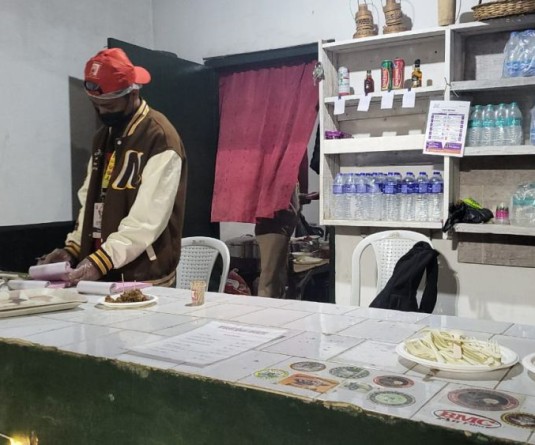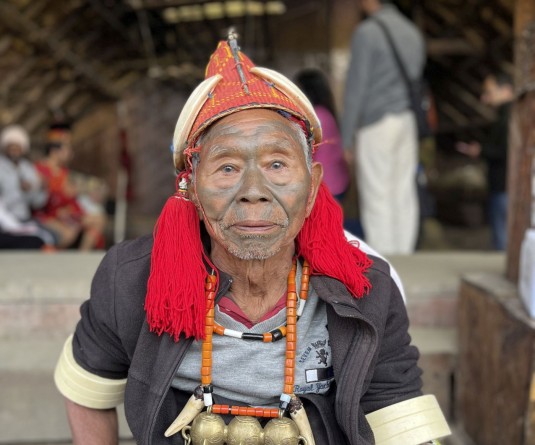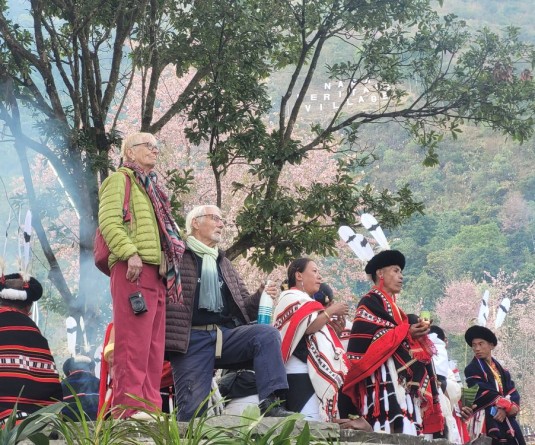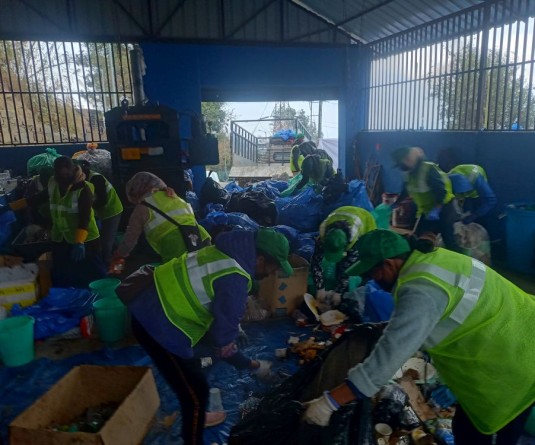A bamboo artisan works on structural beams at a sustainable construction project.
.jpg)
Chizokho Vero
Kohima | November 1
Zynorique Initiatives, a Nagaland-based architectural and design firm, has been pioneering bamboo-based construction across the state and beyond since 2004. Founded in 2003 by architects Richard Belho and Kezhagwetuo (Ato) Peseyie, the firm initially worked with RCC structures before shifting focus to bamboo architecture in 2004–05.
Zynorique Initiatives is registered under the Government of Nagaland, with the primary objective of training and empowering Naga youth in creative and sustainable building practices. The organisation aims to encourage self-employment, promote environmental conservation, and preserve Nagaland’s artistic and cultural heritage.
Explaining their shift toward bamboo, Belho said, “One reason we chose bamboo is that with RCC construction, money flows out of the state. But with bamboo, resources circulate locally and benefit our people.”
.webp)
Zynorique’s first major bamboo project came in 2004, when it designed pavilions for the Industries Department Expo at Khuochiezie (Kohima Local Ground). What began as a temporary structure was transformed into a semi-permanent installation on the advice of Chief Minister Dr Neiphiu Rio.
Soon after, Zynorique undertook the construction of a 20,000 sq ft Bamboo Pavilion at Kisama as a construction-cum-training programme with technical expert Ar. Chenithung Kikom — becoming the largest bamboo structure of its kind in India at the time. Belho said this initiative played a key role in the launch of the Nagaland Bamboo Development Agency (NBDA).
.webp)
Since then, Zynorique has worked extensively with NBDA and the National Mission on Bamboo Applications (NMBA), building bamboo-based wayside amenities across Nagaland. This partnership also led to the establishment of the Nagaland Bamboo Resource Centre, equipped with machinery and a treatment plant provided by NMBA.
Zynorique, along with various state departments, has executed numerous bamboo projects at key locations, including the Hornbill Festival venue in Kisama, Agri Expo site in Dimapur, Niathu Resort, Chapru, and 'Angya' structures through the DUDA department in all district headquarters of Eastern Nagaland.
.webp)
It has also constructed a couple of classrooms at NIT Chümoukedima, a prefabricated structure at Simlipal Tiger Reserve and National Park in Odisha, a parking shed at IIM Bangalore, and resorts in Bihar and Indore constructed with architects trained from Seithogei.
Belho said he continues to train architects from across the country, with Zynorique mentoring many who now independently handle projects.
“Till now, we are trying to promote bamboo as much as we can because there is huge potential,” Belho stated, highlighting that Nagaland is home to more than 46 species of bamboo. He emphasized the cultural comfort with the material, noting, “Nagas have been traditionally using bamboo, and it is very comfortable for us to use bamboo as construction material.”
Belho maintained that bamboo is a sustainable and safe building material when properly treated. “It is not very easy to burn a bamboo structure if one treats it in the Japanese way i.e. carbonising. If you carbonise the whole bamboo, then it cannot burn,” he explained.
.webp)
Highlighting the advantages of bamboo, he said that in the event of an earthquake, even if a structure is partially damaged, it is always repairable. He observed that bamboo is ideal for constructing essential community buildings in far-flung villages. “Our schools, churches and large public places in far-flung villages can be built with bamboo. Even if calamity comes, it is always reparable, manageable and safer,” he said.
Addressing concerns about longevity, he clarified that the durability of bamboo structures depends on proper treatment and maintenance. “If it is exposed to undesirable elements and not treated well, it can deteriorate within years,” he cautioned.
However, with basic care, its lifespan can be extended significantly. “If it is done with basic treatment, painting, and not allowing sunlight to get into it, it can last for 30 to 40 years,” he said, adding, “If it is well protected and provided proper maintenance, it can go for even a thousand years.”
.webp)
“Because bamboo is a natural material and it does not undergo chemical deterioration. As long as it is treated properly, it can last longer than a concrete building,” he added.
Belho also shared that traditional house construction involves community participation, helping each other and keeping traditional skills alive. He said the world is increasingly looking at bamboo for larger roles — including charcoal production, ethanol production, and bamboo fibre as a potential material for cosmetic purposes.
Currently, Zynorique supplies treated bamboo outside Nagaland. “There is huge demand from all over India. We are not able to meet all requirements,” he noted.
Stating that bamboo plantation has tremendous scope, Belho stressed the need for mass planting and government support. “When you promote bamboo structure construction, you give the opportunity for money to circulate among our local people right from the village,” he said.
.webp)
“We are forgetting how to use it because we don’t allow ourselves to promote or to use it. Government should come in and take it seriously,” he emphasized.
“We have to understand that NBDA should not limit itself to just plantation or training workers.” He suggested that the agency invest in major projects. “This is one area where it can impact a lot of people,” he said.
Meanwhile, Zynorique Initiatives is constructing a large Bamboo Farmers’ Hall at Seithogei along National Highway-29. The project is partially sponsored under the Innovative Scheme by the Chief Minister of Nagaland. Besides facilitating skill training, the hall will showcase the potential of bamboo structure houses. It will also function as a rentable hall for various activities. With a 700-seat capacity, it will include multiple workshop spaces.
“I am trying to promote bamboo structure houses as much as possible for people to become comfortable with bamboo,” Belho stated.
Zynorique Initiatives trains a minimum of 40–50 people every year in bamboo skill activities. In total, it has already trained 2,500 skilled workers. Many trained individuals are now working outside the state and engaging in various projects, Belho said.
This is the first report of the four-part series highlighting the experiences and challenges faced by the construction industry in Nagaland as part of the KPC-NBOCWWB Media Fellowship 2025.






